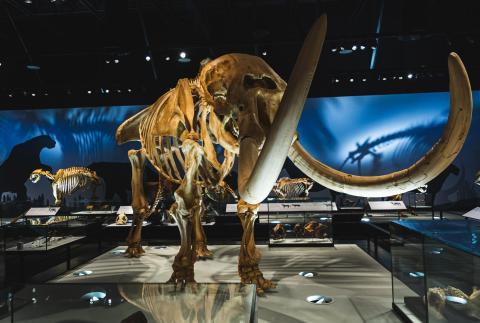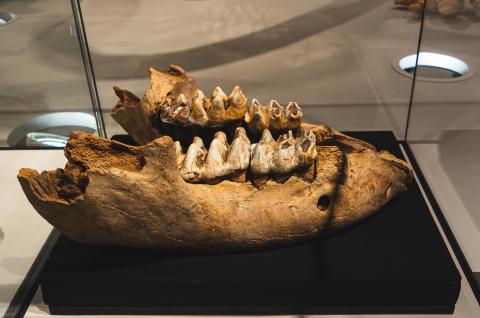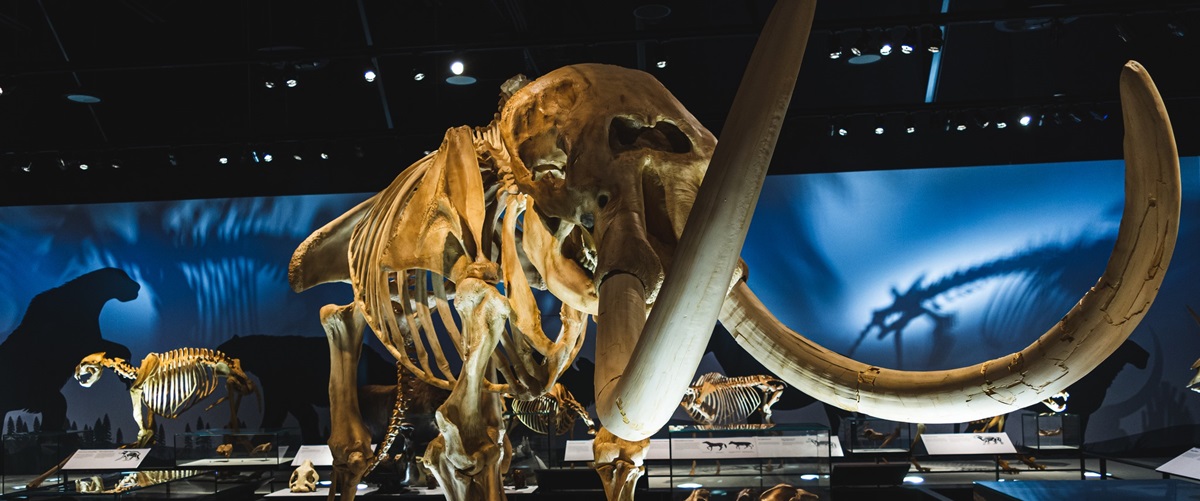Where the Mastodons Roamed
By Nick Carter, Marketing and Communications Volunteer
April 23, 2025
If you could travel back to the Pleistocene Epoch or “Ice Age” in Alberta, it wouldn’t be surprising to see mammoths striding across the prairie. There was another, rarer kind of elephant-like beast around in those days, though, and that’s the mastodon.

While they might look similar to mammoths at first glance, mastodons had a stockier build with a lower skull dome. Their tusks were shorter and less curved than those of mammoths as well, and the high-cusped molar teeth of mastodons, suited for browsing on trees and shrubs, looked very different from those of grazing mammoths. While mammoths were true elephants, part of the family Elephantidae alongside modern African and Asian elephants, the mastodons were part of a more basal family called the Mammutidae.
During the late Pleistocene there were two mastodon species inhabiting North America. One was the Mammut americanum, or the American mastodon. This familiar species, found throughout much of North America, has been known to science for over 200 years. A second species, the Pacific mastodon (Mammut pacificus), was described in 2019 based on fossils from California, further west than the American mastodon seems to have ranged (Dooley et al., 2019). One significant difference between these two species can be found in their teeth, especially the third molar, which was relatively narrower in the Pacific mastodon. Another is the upper hindleg bone, or femur, which in the Pacific mastodon was wider in the middle. Lastly, some American mastodon individuals had small tusks in the lower jaw, while the Pacific mastodon lacked these entirely.
Since this discovery, palaeontologists have wanted to know exactly where on the continent each species lived, and whether or not there was any overlap or fluctuations in their respective ranges. Previous studies have reported the Pacific mastodon as far east as Idaho and Montana (Dooley et al., 2019; McDonald et al., 2020), but where else did this species’ range extend to? Were there any localities where these two mastodon species lived alongside one another for at least some period of time? Now, a recently-published study that included RAM’s Curator of Quaternary Studies Chris Jass, addresses these questions (Dooley et al., 2025).
To do this, the authors analyzed and compared mastodon specimens from five regions in western North America: Jalisco and Hidalgo in west-central Mexico, Oregon and Washington in the United States, and Alberta. They started by looking at third molar teeth from these regions to see if they were significantly thinner than the average American mastodon third molar. If so, the specimen could confidently be identified as a Pacific mastodon. Where identification by tooth was less clear, other factors like the width of the femur and presence of lower jaw tusks were assessed to narrow each specimen down. For example, if a mastodon specimen has only somewhat narrow molar teeth but a relatively wide femur bone, that would be a decent identification that it’s a Pacific mastodon. Tusks in the lower jaw, however, always mean a specimen is an American mastodon.
All identifiable material from Oregon and Mexico were found to be from Pacific mastodons. Specimens from Washington were less clear, and couldn’t be confidently identified to either species. As for Alberta, mastodon fossils are comparatively rare here, unlike the more common mammoths, as previous studies by RAM palaeontologists have found (Jass & Barron-Ortiz, 2017). Most known specimens are represented by material recovered from industrial gravel pits around Edmonton and are now housed in the collections at RAM. One lower jaw was found to have relatively wide molar teeth and tusk sockets, making it an American mastodon.
Another RAM specimen, an upper third molar, was more of a challenge to identify. A precise measurement of this tooth could indicate what species it belonged to, but the first two enamel ridges or “lophs” are damaged, making the tooth incomplete. The authors solved this problem by calculating the range of possibilities for the overall width of mastodon molars based on the width of the third tooth loph. Applying this to the broken tooth, they were able to calculate the likely maximum and minimum sizes and found the length-to-width ratio to be consistent with Pacific mastodons, and so that species is likely what this tooth came from.
The results of this study lead to some interesting conclusions. As the Pacific mastodon is already known from California, Idaho, and Montana, its presence in Oregon isn’t a surprise, and we can’t rule it out for Washington either. This species’ presence in west-central Mexico, however, was certainly unexpected given that all known mastodon remains from north of there in southern Texas and New Mexico are from American mastodons (Dooley et al., 2019). It seems as though the Pacific mastodon range curved eastwards from the west coast into northern Mexico, and the boundary between it and the American mastodon lay somewhere in there.

As for Alberta, the findings from here raise more questions. We have specimens of both American and Pacific mastodons from the Edmonton area, all of which are at least older than 40,000 years, but we can’t get a precise age for them through radiocarbon dating. This means we can’t tell for sure if what we’re seeing is the two species coexisting in the same place at the same time, or if their ranges fluctuated during the Pleistocene with one species moving into a region that was once the home of the other. If American and Pacific mastodons did coexist in Alberta, they might have shown a high degree of niche partitioning. This is where two species with similar anatomy or lifestyles living in the same region start pursuing different resources like food or habitat to avoid directly competing with each other.
If these mastodons didn’t coexist but instead their ranges had fluctuated, this could reflect changes over time to the environment of Alberta during the Pleistocene, which favoured the movement of one species into the former range of the other. Future studies examining the relative ages of mastodons in Alberta could help clarify this situation.
A previous study of mastodon genetics (Karpinski et al., 2020) found that their populations tended to show high levels of endemism, or the tendency to be found in one certain region. Except, that is, for mastodons in Alberta, which showed genetic ties to populations from Alaska, Missouri, and Mexico. Not only that, but the Pacific mastodon specimen from Alberta shows genetic affinities to specimens of that species from Mexico. Could this be evidence for a northward migration of Pacific mastodons into Alberta at some point? Possibly.
Genetic evidence shows that American and Pacific mastodons diverged from their last common ancestor about 3 million years ago, during the Pliocene epoch (Karpinski et al., 2020). So, in addition to more data on the precise ages of known mastodon specimens, future studies on the early records of these two species could tell palaeontologists more about their evolution and biology, as well as the environmental changes that led to their divergence and how they came to live where and when they did.
Scientists continue to gather information on our prehistoric past, and anyone in Alberta can help. If you think you’ve found an Ice Age fossil in Alberta, contact RAM palaeontologists, and they’ll ensure the specimen finds a safe and permanent home at the museum.
References
Dooley Jr., Alton C.; Scott, Eric; Green, Jeremy; Springer, Kathleen B.; Dooley, Brett S.; Smith, Gregory James (2019). "Mammut pacificus sp. nov., a newly recognized species of mastodon from the Pleistocene of western North America". PeerJ. 7: e6614. doi:10.7717/peerj.6614. PMC 6441323. PMID 30944777.
McDonald AT, Atwater AL, Dooley Jr AC, Hohman CJH. 2020. The easternmost occurrence of Mammut pacificus (Proboscidea: Mammutidae), based on a partial skull from eastern Montana, USA. PeerJ 8:e10030 https://doi.org/10.7717/peerj.10030
Dooley AC Jr, Widga C, Stoneburg BE, Jass C, Bravo-Cuevas VM, Boehm A, Scott E, McDonald AT, Volmut M. 2025. Re-evaluation of mastodon material from Oregon and Washington, USA, Alberta, Canada, and Hidalgo and Jalisco, Mexico. PeerJ 13:e18848 https://doi.org/10.7717/peerj.18848
Jass C, Barron-Ortiz C. 2017. A review of Quaternary proboscideans from Alberta, Canada. Quaternary International 443(42):88-104
Karpinski, E., Hackenberger, D., Zazula, G. et al. American mastodon mitochondrial genomes suggest multiple dispersal events in response to Pleistocene climate oscillations. Nat Commun 11, 4048 (2020). https://doi.org/10.1038/s41467-020-17893-z
